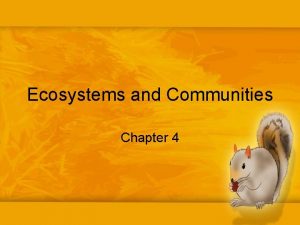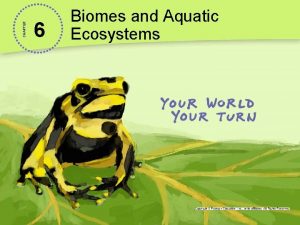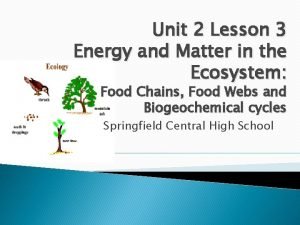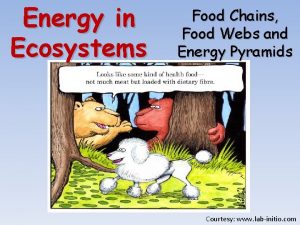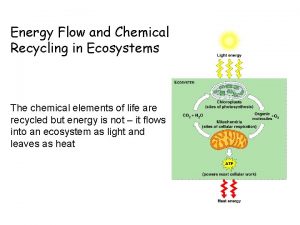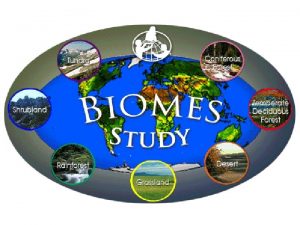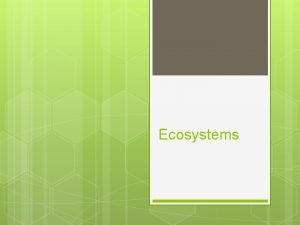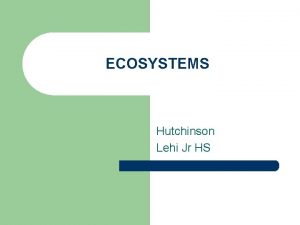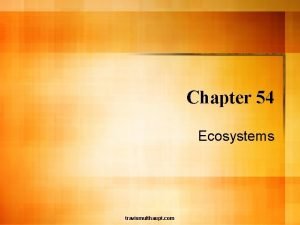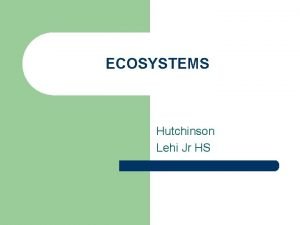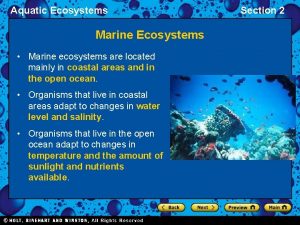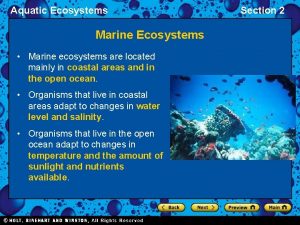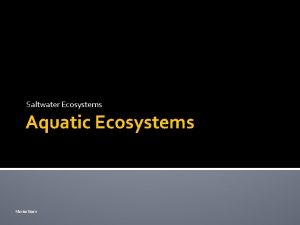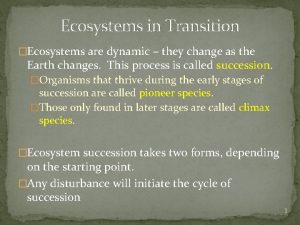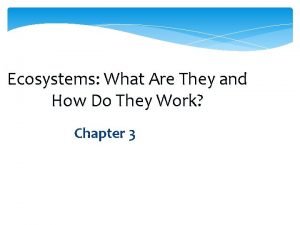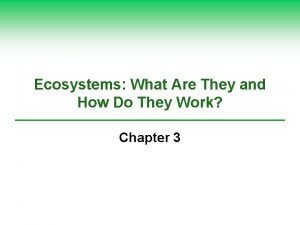Ecosystems What Are They and How Do They














- Slides: 14

Ecosystems: What Are They and How Do They Work? G. Tyler Miller’s Living in the Environment 14 th Edition Chapter 4

Essential Questions / Objectives Define ecology. List and distinguish among five levels of organization of matter that are the focus of the realm of ecology List the characteristics of life Distinguish among lithosphere, hydrosphere, atmosphere, and ecosphere. Briefly describe how the sun, gravity, and nutrient cycles sustain life on Earth. Compare the flow of matter and the flow of energy through the biosphere Define soil horizon. Briefly describe 4 soil layers. Using Figure 4 -25 on p. 75 in the text, compare soil profiles of five important soil types Describe a fertile soil. In doing so, be sure to refer to soil texture, porosity, loam, and acidity

Essential Questions / Objectives Distinguish between an open system and a closed system. Name and describe three types of biogeochemical cycles Define abiotic component of an ecosystem. List three important physical factors and three important chemical factors that have large effects on ecosystems Summarize the law of tolerance. Compare limiting factors in terrestrial and aquatic ecosystems Define biotic component of an ecosystem. Distinguish between producers and consumers. List and distinguish four types of consumers. Distinguish among scavengers, detritus feeders and decomposers. Distinguish between photosynthesizers and chemosynthesizers; aerobic respiration and anaerobic respiration

Essential Questions / Objectives Distinguish between food chains and food webs; a grazing food web and detrital food web. Apply the second law of energy to food chains and pyramids of energy, which describe energy flow in ecosystems. Explain how there may be exceptions to pyramids of numbers and biomass, but not energy Evaluate which ecosystems show the highest average net primary productivity and which contribute most to global net primary productivity Briefly describe the historical development and distinguishing features of three approaches ecologists use to learn about ecosystems: field research, laboratory research, and systems analysis Define ecosystem service. List five examples of ecosystem services. Distinguish among three types of biodiversity. Briefly state two principles to sustain ecosystems

Ecosystem Organization Overview Biosphere- Zone of earth where life is found. It consists of parts of the atmosphere (the troposphere), hydrosphere (mostly surface water and groundwater), and lithosphere (mostly soil and surface rocks and sediments on the bottoms of oceans and other bodies of water) where life is found. Sometimes called the ecosphere Ecosystems- Community of different species interacting with one another and with the chemical and physical factors making up its nonliving environment Communities- Populations of all species living and interacting in an area at a particular time Populations- Group of individual organisms of the same species living in a particular area Organisms Any form of life (species)- group of organisms that resemble one another in appearance, behavior, chemical makeup and processes, and genetic structure. Organisms that reproduce sexually are classified as members of the same species only if they can actually or potentially interbreed with one another and produce fertile offspring

Ecosystem Components The major components of ecosystems are abiotic (nonliving) water, air, nutrients, solar energy, and biotic (living) plants, animals, and microbes.

Ecosystem Factors Ecosystem characteristics include a range of tolerance to physical and chemical environments by the ecosystem's populations Law of tolerance: The distribution of a species in an ecosystem is determined by the levels of one or more physical or chemical factors being within the range tolerated by that species. Aquatic life zones can be limited by the dissolved oxygen (DO) content in the water, temperature, p. H or by the salinity Sugar Maple The limiting factor principle states that too much or too little of any abiotic factor can limit or prevent growth of a population, even if all other factors are at or near the optimum range of tolerance. An abiotic factor such as lack of water or poor soil can be understood here

Ecosystem Components The major biological components of ecosystems are the producers/autotrophs that are self-feeders and the consumers/heterotrophs. Autotrophs photosynthesize making their own food from compounds in the environment (organisms such as green plants and algae). A few specialized producers can convert simple compounds to more complex compounds without sunlight, a process called chemosynthesis. Heterotrophs (consumers) feed on other organisms or their remains. Herbivores feed on plants. Carnivores feed on animals. Omnivores feed on both plants and animals. Detritivores feed on dead organic matter and break it down into smaller molecules Decomposers (bacteria/fungi) break down organic detritus into simpler inorganic compounds.

Detritivores and Decomposer Detritus feeders Bark beetle engraving Long-horned beetle holes Carpenter ant galleries Decomposers Termite and carpenter ant work Dry rot fungus Wood reduced to powder Time progression Mushroom Powder broken down by decomposers into plant nutrients in soil

Ecosystem Components Glucose and other organic compounds are broken down and energy released by the process of aerobic respiration, the use of oxygen to convert organic matter back to carbon dioxide and water. This process is a net chemical change to that of photosynthesis. Photosynthesis: CO 2 + H 2 O Carbon dioxide water CO 2 + H 2 O Light C 6 H 12 O 6 + O 2 Glucose sugar oxygen C 6 H 12 O 6 + O 2 Aerobic Respiration “Cellular Respiration” Some decomposers are able to break down organic compounds without using oxygen. This process is called anaerobic respiration, or fermentation. The end products are compounds such as methane gas, ethyl alcohol, acetic acid, and hydrogen sulfide. Matter is recycled; there is a one-way flow of energy.

Food Chains and Energy Flow in Ecosystems Food chains and food webs help us understand how eaters, the eaten, and the decomposed are interconnected in an ecosystem. The sequence of organisms as they are eaten is a food chain. Food webs are complex networks of interconnected food chains. They are maps of life's interdependence. Trophic levels are feeding levels for organisms within an ecosystem, (1) Producers belong to the first trophic level. (2) Primary consumers belong to the second trophic level. (3)Secondary consumers belong to the (4) third trophic level. Detritivores and decomposers process detritus from all trophic levels. Energy flow in a food web/chain decreases at each succeeding organism in a chain or web. The dry weight of all organic matter within the organisms of a food chain/web is called biomass.

Trophic Levels Humans Blue whale Ecological efficiency is the term that describes the percentage of usable energy transferred as biomass from one trophic level to another and ranges from 2%-40% with 10% being typical. Sperm whale Killer whale Elephant seal Crabeater seal Leopard seal The greater number of trophic levels in a food chain, the greater loss of usable energy. Emperor penguin Adélie penguins Petrel Squid Fish Carnivorous plankton Herbivorous zooplankton Krill Phytoplankton

Ecological Pyramids Pyramid of numbers Pyramid of energy flow Compares the total number of organism at each The pyramid of energy flow trophic level visualizes the loss of usable energy through a food chain. The lower levels of the trophic pyramid support more organisms. If people eat at a lower trophic level (fruits, vegetables, grains directly consumed), Earth can support more people. There is a large loss of energy between successive trophic levels. Pyramid of biomass Compares biomass (The dry weight of all organic matter within the organisms of a food chain/web) at each trophic level

Barred owl Barn owl
 Insidan region jh
Insidan region jh Chapter 4 ecosystems and communities
Chapter 4 ecosystems and communities Savanna biome plants
Savanna biome plants Chapter 6 biomes and aquatic ecosystems
Chapter 6 biomes and aquatic ecosystems Phosphorus cycle pearson education
Phosphorus cycle pearson education Chapter 42 ecosystems and energy
Chapter 42 ecosystems and energy Chapter 3 lesson 3 biomes and aquatic ecosystems
Chapter 3 lesson 3 biomes and aquatic ecosystems Differences between aquatic and terrestrial ecosystems
Differences between aquatic and terrestrial ecosystems How does energy flow in an ecosystem
How does energy flow in an ecosystem Lesson 3 energy and matter in ecosystems answer key
Lesson 3 energy and matter in ecosystems answer key Lab food chains and energy in ecosystems
Lab food chains and energy in ecosystems Energy flow and chemical recycling in ecosystems
Energy flow and chemical recycling in ecosystems Chapter 55 ecosystems and restoration ecology
Chapter 55 ecosystems and restoration ecology Biomes and aquatic ecosystems
Biomes and aquatic ecosystems Section 3 water pollution
Section 3 water pollution

